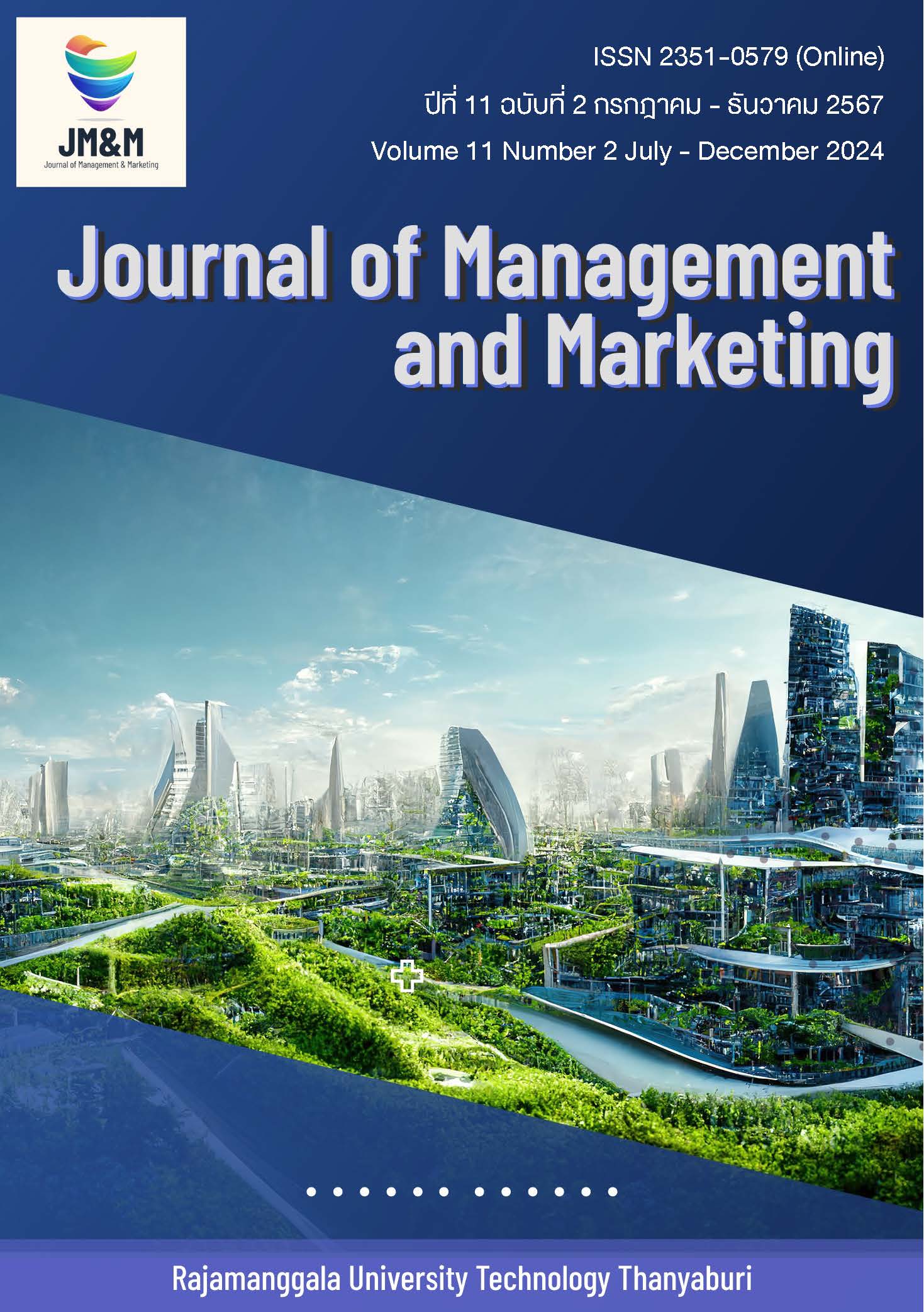FACTORS AFFECTING THE INTENTION TO WATCH TIE-IN IN SHORT-FORM VIDEOS ON THE TIKTOK APPLICATION OF GENERATION Y IN BANGKOK
DOI:
https://doi.org/10.60101/mmr.2024.270517Keywords:
Intention to Watch, short-form video, Tie-inAbstract
This research aims to examine factors influencing the intention to watch short-form videos with embedded advertisements on TikTok among Generation Y in Bangkok. The study draws insights from a purpose sample of 275 consumers who have experienced such videos on the TikTok application The research utilizes an online questionnaire, and the statistical method employed for analysis is multiple regression analysis.
The study's findings reveal that factors related to entertainment, information, passing time, and social interactions significantly influence the attitudes of Generation Y in Bangkok, statistically significant at 0.05 level. However, factors related to relaxation and escape do not impact attitudes. Specifically, within the entertainment, social norm, and attitude-related factors, there is statistically significant influence on the intention to watch tie-in in short-form videos on TikTok application among Generation Y in Bangkok at 0.05 significance level. This research holds practical value and serves as
a guide for businesses aiming to create tie-in in short-form videos on the TikTok application. It can inform marketing strategies for organizations, offering a deeper understanding of consumer behavior.
References
เขมณา พรหมรักษา และ สุทธิศักดิ์ ไกรสรสุธาสินี. (2557). การรับรู้และทัศนคติของผู้บริโภคต่อโฆษณาแฝงทางโทรทัศน์: กรณีศึกษา: ละครชุดฮอร์โมนวัยว้าวุ่น [การค้นคว้าอิสระปริญญามหาบัณฑิต ไม่ได้ตีพิมพ์]. มหาวิทยาลัยธรรมศาสตร์.
ณัฐชนา สุรดินทร์ และ ภิญรดา เมธารมณ์. (2559). ทัศนคติของผู้บริโภคต่อ viral video online ที่มีโฆษณาแฝงและไม่มีโฆษณาแฝง [การค้นคว้าอิสระปริญญามหาบัณฑิต ไม่ได้ตีพิมพ์]. มหาวิทยาลัยธรรมศาสตร์.
ธนาคารกรุงเทพ. (2564). เรื่อง Tie-inโฆษณาออนไลน์อย่างไร ผู้ชมไม่รู้สึกว่าขายของ. https://www.bangkokbanksme.com/en/how-does-tie-in-advertise-online
นันทพัทธ์ โนนศรีเมือง และ สดชื่น อุตอามาตย์. (2565). ผลกระทบของการสื่อสารการตลาดผ่านสื่อสังคมออนไลน์ที่มีต่อความตั้งใจซื้อสินค้าเพื่อสิ่งแวดล้อมของผู้บริโภคเจนเนอเรชันวาย (Generation Y). Journal of Accountancy and Management, 14(3), 36-49.
พรเลิศ ภาระสกุล. (2559). อิทธิพลของแรงจูงใจปัจจัยผลักที่มีต่อแรงจูงใจปัจจัยดึงของนักท่องเที่ยว ชาวจีนที่เดินทางมาท่องเที่ยวประเทศไทย. Suthiparithat, 30(96), 172-184.
วรวรรณ องค์ครุฑรักษา. (2564). เรื่องโฆษณาแฝง. https://shorturl.asia/rmYHe
สาธิดา ยุวทองไท. (2565). ปัจจัยที่ส่งผลต่อการเลือกรับชมไลฟ์สดผ่านช่องทาง Facebook ซึ่งส่งผล ต่อทัศนคติในตัวแบรนด์ [สารนิพนธ์ปริญญามหาบัณฑิต ไม่ได้ตีพิมพ์]. มหาวิทยาลัยมหิดล.
อุทัยวรรณ สายพัฒนะ และ ฉัตรศิริ ปิยะพิมลสิทธิ์. (2559). Collinearity Parichart Journal, 17(1), 55-62. https://so05.tci-thaijo.org/index.php/parichartjournal/article/view/69983
Ajzen, I. (1991). The theory of planned behavior. Organizational behavior and human decision processes, 50(2), 179-211.
Campbell & Pritchard. (1976). Motivation theory in industrial and organizational psychology. In M. D. Dunnette (Ed.), Handbook of industrial and organizational psychology (63-130). Rand McNally.
Chan, M. L., Chee, H. L., Chin, S. P., & Sim, G. X. (2014). Consumers' attitude towards online advertising: the study on information responses [Unpublished Doctoral dissertation]. Universiti Tunku Abdul Rahman (UTAR).
Chen, C. C., & Lin, Y. C. (2018). What drives live-stream usage intention? The perspectives of flow, entertainment, social interaction, and endorsement. Telematics and Informatics, 35(1), 293-303.
Crompton, J. L. (1979). Motivations for pleasure vacation. Annals of tourism research, 6(4), 408-424.
Csikszentmihalyi, M., & Csikzentmihaly, M. (1990). Flow: The psychology of optimal experience. Harper & Row.
Cunningham, S., & Craig, D. (2019). Creator governance in social media entertainment. Social Media+ Society, 5(4), https://doi.org/10.1177/2056305119883428
Curras-Perez, R., Ruiz-Mafe, C., & Sanz-Blas, S. (2014). Determinants of user behaviour and recommendation in social networks: An integrative approach from the uses and gratifications perspective. Industrial Management & Data Systems, 114(9), 1477-1498.
De Battista, I., Curmi, F., & Said, E. (2021). Influencing factors affecting young people’s attitude towards online advertising: A systematic literature review. International Review of Management and Marketing, 11(3), 58-66.
De Jaegher, H., Di Paolo, E., & Gallagher, S. (2010). Can social interaction constitute social cognition?. Trends in Cognitive Sciences, 14(10), 441-447. https://doi.org/10.1016/j.tics.2010.06.009
Dwinanda, B., Syaripuddin, F. A., & Hendriana, E. (2022). Examining the extended advertising value model: A case of tiktok short video ads. Mediterranean Journal of Social & Behavioral Research, 6(2), 35-44.
Dym, B., & Fiesler, C. (2020). Social norm vulnerability and its consequences for privacy and safety in an online community. Proceedings of the ACM on Human-Computer Interaction, 4(CSCW2), 1-24.
Ferguson, D. A., & Perse, E. M. (2000). The World Wide Web as a functional alternative to television. Journal of broadcasting & electronic media, 44(2), 155-174.
Flavián, C., & Gurrea, R. (2009). Users' motivations and attitude towards the online press. Journal of Consumer Marketing, 26(3), 164-174.
Gaber, H. R., Wright, L. T., & Kooli, K. (2019). Consumer attitudes towards Instagram advertisements in Egypt: The role of the perceived advertising value and personalization. Cogent Business & Management, 6(1), https://doi.org/10.1080/23311975.2019.1618431
Hair, J. F., Jr., Black, W. C., Babin, B. J., & Anderson, R. E. (2019). Multivariate data analysis (8th ed.). Cengage Learning.
Harris, E. (2023). Top 7 types of short-form video. https://www.theleap.co/blog/short-form-video/
Hoàng, C., Nguyen, H. D. U., Duong, T. L. P., Nguyen, H. P., Nguyen, H. T. N., & Le, T. T. T. (2022). The impact of TikTok advertising on Young People’s online shopping behavior during the COVID-19 pandemic. International Journal of Smart Business and Technology, 10(1), 145-162.
Insightera. (2022). Content Types for 2023 “Simple & Short. https://www.insightera.co.th/content-types-for-2023-simple-short/
Katz, E., Blumler, J. G., & Gurevitch, M. (1973). Uses and gratifications research. The public opinion quarterly, 37(4), 509-523.
Kim, Y., & Han, J. (2014). Why smartphone advertising attracts customers: A model of web advertising, flow, and personalization. Computers in Human Behavior, 33, 256-269. https://doi.org/10.1016/j.chb.2014.01.015
Knight, K., (2010). User view: 97% if consumers research products online. http://www.bizreport.com/2010/03/user_view_97_of_consumers_researchproducts_online.html
Koay, K. Y., Teoh, J. Y., & Cheung, M. L. (2023). Understanding factors influencing viewers’ intention to watch video game live streaming on Twitch: Combined use of PLS-SEM and NCA. First Monday, 28(5), https://doi.org/10.5210/fm.v28i5.12644
Kola, O., Akinyele, S.T. (2010), Evaluation of effectiveness of marketing communication mix elements in Nigerian service sector. Pakistan Journal of Social Sciences, 7(2), 76-80.
Lee, J., & Lee, M. (2011). Factors influencing the intention to watch online video advertising. Cyberpsychology, Behavior, and Social Networking, 14(10), 619-624.
Lee, J., Kim, M., Ham, C. D., & Kim, S. (2017). Do you want me to watch this ad on social media? The effects of norms on online video ad watching. Journal of Marketing Communications, 23(5), 456-472.
Luna, B., Minshew, N., Garver, K. E., Lazar, N. A., Thulborn, K., Eddy, W., & Sweeney, J. (2002). Neocortical system abnormalities in autism: An fMRI study of spatial working memory. Neurology, 59(6), 834–840. https://doi.org/10.1212/WNL.59.6.834
MacKenzie, S. B., & Lutz, R. J. (1989), An empirical examination of the structural antecedents of attitude toward the ad in an advertising pretesting context. Journal of Marketing, 53(2), 48-65.
Martins, J., Costa, C., Oliveira, T., Gonçalves, R., & Branco, F. (2019). How smartphone advertising influences consumers' purchase intention. Journal of Business Research, 94, 378-387.
McNeish, D. (2018). Thanks coefficient alpha, we’ll take it from here. Psychological methods, 23(3), 412-433. https://doi.org/10.1037/met0000144
Mehta, A. (2000), Advertising attitudes and advertising effectiveness. Journal of Advertising Research, 40(3), 67-71.
Morreale, C. (2022). The influence of social media video marketing on consumers purchase intentions: the role of video length. https://matheo.uliege.be/bitstream/2268.2/14267/4/MORREALECe%CC%81line-Me%CC%81moireRecherche-s171124-2022.pdf
Neus, F. (2020). Interaction in social live streaming services–Importance and influential factors. In Event marketing in the context of higher education marketing and digital environments (pp. 101-120). Springer Gabler, Wiesbaden.
Papacharissi, Z., & Rubin, A. M. (2000). Predictors of Internet use. Journal of broadcasting & electronic media, 44(2), 175-196.
Putri, H. A., & Sugiarto, C. (2023). The Effect of Celebrity-Program Congruence and Celebrity Credibility on Intention to Watch Sports Video on YouTube. Journal of Indonesia Marketing Association (IMA), 2(1), 25-40.
Puwandi, P. H., DE, G. T., & Brasali, N. (2020). The factors affecting consumer response towards online video advertisement: YouTube as a platform. International Journal of Multicultural and Multireligious Understanding, 7(2), 375-390.
Ramadhani, S., Suroso, A. I., & Ratono, J. (2020). Consumer attitude, behavioral intention, and watching behavior of online video advertising on youtube. Jurnal Aplikasi Manajemen, 18(3), 493-503.
Richard, M. O., & Chandra, R. (2005). A model of consumer web navigational behavior: conceptual development and application. Journal of business Research, 58(8), 1019-1029.
Rost, K., Stahel, L., & Frey, B. S. (2016). Digital social norm enforcement: Online firestorms in social media. PLoS one, 11(6), e0155923.
Vroom, (1964). Work and motivation. New York: Wiley.
Webler, F., & Andersen, M. (2022). Measurement in the Age of Information. Information, 13(3), 111. https://doi.org/10.3390/info13030111 https://www.mdpi.com/journal/information
Whiting, A., & Williams, D. (2013). Why people use social media: a uses and gratifications approach. Qualitative market research: an international journal, 16(4), 362-369.
Wu, J. H., & Wang, S. C. (2005). What drives mobile commerce?: An empirical evaluation of the revised technology acceptance model. Information & management, 42(5), 719-729.
Yang, C., Hsu, Y. C., & Tan, S. (2010). Predicting the determinants of users' intentions for using YouTube to share video: moderating gender effects. Cyberpsychology, Behavior, and Social Networking, 13(2), 141-152.
Ye, Y. (2024). Visual rhetoric in advertising of China’s new tea beverage industry, using HEYTEA as an example. In SHS Web of Conferences EDP Sciences.
Zahid, N. M., Khan, J., & Tao, M. (2023). Exploring mindful consumption, ego involvement, and social norms influencing second-hand clothing purchase. Current Psychology, 42(16), 13960-13974.
Downloads
Published
How to Cite
Issue
Section
License
Copyright (c) 2024 Journal of Management and Marketing, Rajamangala University of Technology Thanyaburi

This work is licensed under a Creative Commons Attribution-NonCommercial-NoDerivatives 4.0 International License.
บทความที่ได้รับการตีพิมพ์เป็นลิขสิทธิ์ของ ผู้นิพนธ์
ข้อความที่ปรากฏในบทความแต่ละเรื่องในวารสารวิชาการเล่มนี้เป็นความคิดเห็นส่วนตัวของผู้เขียนแต่ละท่านไม่เกี่ยวข้องกับมหาวิทยาลัยเทคโนโลยีราชมงคลธัญบุรี และคณาจารย์ท่านอื่น ในมหาวิทยาลัยฯ แต่อย่างใด ความรับผิดชอบองค์ประกอบทั้งหมดของบทความแต่ละเรื่องเป็นของผู้เขียนแต่ละท่าน หากมีความผิดพลาดใดๆ ผู้เขียนแต่ละท่านจะรับผิดชอบบทความของตนเองแต่ผู้เดียว







